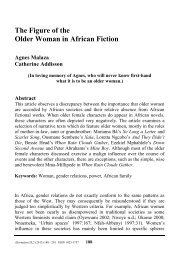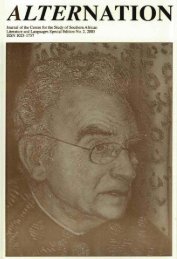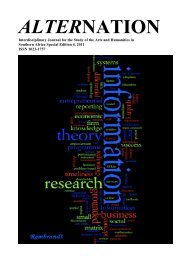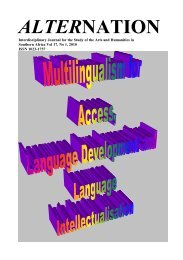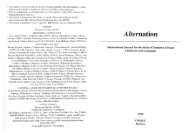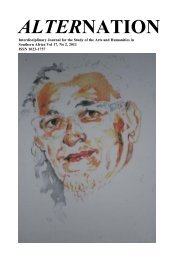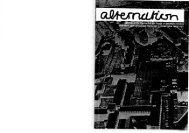- Page 1 and 2: ALTERNATION Journal of the Centre f
- Page 3 and 4: Alternation Interdisciplinary Journ
- Page 5 and 6: Introduction: Themes in Present-day
- Page 7 and 8: Introduction: Themes in Present-day
- Page 9 and 10: Introduction: Themes in Present-day
- Page 11 and 12: Introduction: Themes in Present-day
- Page 13 and 14: … Impact of … Entrepreneurial N
- Page 15: … Impact of … Entrepreneurial N
- Page 19 and 20: … Impact of … Entrepreneurial N
- Page 21 and 22: … Impact of … Entrepreneurial N
- Page 23 and 24: … Impact of … Entrepreneurial N
- Page 25 and 26: … Impact of … Entrepreneurial N
- Page 27 and 28: … Impact of … Entrepreneurial N
- Page 29 and 30: … Impact of … Entrepreneurial N
- Page 31 and 32: … Impact of … Entrepreneurial N
- Page 33 and 34: … Impact of … Entrepreneurial N
- Page 35 and 36: … Impact of … Entrepreneurial N
- Page 37 and 38: … Impact of … Entrepreneurial N
- Page 39 and 40: Effective Service Delivery Via Cust
- Page 41 and 42: Effective Service Delivery Via Cust
- Page 43 and 44: Effective Service Delivery Via Cust
- Page 45 and 46: Effective Service Delivery Via Cust
- Page 47 and 48: Effective Service Delivery Via Cust
- Page 49 and 50: Effective Service Delivery Via Cust
- Page 51 and 52: Effective Service Delivery Via Cust
- Page 53 and 54: Effective Service Delivery Via Cust
- Page 55 and 56: Effective Service Delivery Via Cust
- Page 57 and 58: Effective Service Delivery Via Cust
- Page 59 and 60: Effective Service Delivery Via Cust
- Page 61 and 62: References Effective Service Delive
- Page 63 and 64: Implications for e-Business Readine
- Page 65 and 66: Implications for e-Business Readine
- Page 67 and 68:
Implications for e-Business Readine
- Page 69 and 70:
Implications for e-Business Readine
- Page 71 and 72:
Central Tendency Statistics Implica
- Page 73 and 74:
Correlations Implications for e-Bus
- Page 75 and 76:
Implications for e-Business Readine
- Page 77 and 78:
Implications for e-Business Readine
- Page 79 and 80:
Chi-Square Test Implications for e-
- Page 81 and 82:
Implications for e-Business Readine
- Page 83 and 84:
Implications for e-Business Readine
- Page 85 and 86:
Implications for e-Business Readine
- Page 87 and 88:
Implications for e-Business Readine
- Page 89 and 90:
Implications for e-Business Readine
- Page 91 and 92:
The Impact of Communication on Cust
- Page 93 and 94:
The Impact of Communication on Cust
- Page 95 and 96:
The Impact of Communication on Cust
- Page 97 and 98:
The Impact of Communication on Cust
- Page 99 and 100:
The Impact of Communication on Cust
- Page 101 and 102:
The Impact of Communication on Cust
- Page 103 and 104:
The Impact of Communication on Cust
- Page 105 and 106:
The Impact of Communication on Cust
- Page 107 and 108:
The Impact of Communication on Cust
- Page 109 and 110:
The Impact of Communication on Cust
- Page 111 and 112:
The Impact of Communication on Cust
- Page 113 and 114:
The Impact of Communication on Cust
- Page 115 and 116:
The Impact of Communication on Cust
- Page 117 and 118:
The Impact of Communication on Cust
- Page 119 and 120:
The Impact of Communication on Cust
- Page 121 and 122:
Conclusion The Impact of Communicat
- Page 123 and 124:
The Impact of Communication on Cust
- Page 125 and 126:
The Learning Organization in a Glob
- Page 127 and 128:
The Learning Organization in a Glob
- Page 129 and 130:
The Learning Organization in a Glob
- Page 131 and 132:
A masculine society is defined as:
- Page 133 and 134:
The Learning Organization in a Glob
- Page 135 and 136:
The Learning Organization in a Glob
- Page 137 and 138:
The Learning Organization in a Glob
- Page 139 and 140:
The Learning Organization in a Glob
- Page 141 and 142:
The Regulation of Advertising to Ch
- Page 143 and 144:
The Regulation of Advertising to Ch
- Page 145 and 146:
The Regulation of Advertising to Ch
- Page 147 and 148:
The Regulation of Advertising to Ch
- Page 149 and 150:
The Regulation of Advertising to Ch
- Page 151 and 152:
The Regulation of Advertising to Ch
- Page 153 and 154:
Brazil Consumer Protection Law (Law
- Page 155 and 156:
The Regulation of Advertising to Ch
- Page 157 and 158:
Establish ed UNITED STATES OF AMERI
- Page 159 and 160:
The Regulation of Advertising to Ch
- Page 161 and 162:
The Regulation of Advertising to Ch
- Page 163 and 164:
The Regulation of Advertising to Ch
- Page 165 and 166:
The Regulation of Advertising to Ch
- Page 167 and 168:
The Regulation of Advertising to Ch
- Page 169 and 170:
The Regulation of Advertising to Ch
- Page 171 and 172:
Assessing Members’ Perceptions of
- Page 173 and 174:
Assessing Members’ Perceptions of
- Page 175 and 176:
Assessing Members’ Perceptions of
- Page 177 and 178:
Assessing Members’ Perceptions of
- Page 179 and 180:
Assessing Members’ Perceptions of
- Page 181 and 182:
Assessing Members’ Perceptions of
- Page 183 and 184:
Assessing Members’ Perceptions of
- Page 185 and 186:
MO r -0.040 p 0.761 * p < 0.01 Key
- Page 187 and 188:
IR - Interpersonal relationships MO
- Page 189 and 190:
Assessing Members’ Perceptions of
- Page 191 and 192:
Assessing Members’ Perceptions of
- Page 193 and 194:
Assessing Members’ Perceptions of
- Page 195 and 196:
Assessing Members’ Perceptions of
- Page 197 and 198:
Assessing Members’ Perceptions of
- Page 199 and 200:
Assessing Members’ Perceptions of
- Page 201 and 202:
Perceptions of the Measurability, I
- Page 203 and 204:
Perceptions Of The Measurability
- Page 205 and 206:
Perceptions Of The Measurability
- Page 207 and 208:
Perceptions Of The Measurability
- Page 209 and 210:
Perceptions Of The Measurability
- Page 211 and 212:
Perceptions Of The Measurability
- Page 213 and 214:
Perceptions Of The Measurability
- Page 215 and 216:
Perceptions Of The Measurability
- Page 217 and 218:
Perceptions Of The Measurability
- Page 219 and 220:
Perceptions Of The Measurability
- Page 221 and 222:
Perceptions Of The Measurability
- Page 223 and 224:
Action Research: The Participative
- Page 225 and 226:
Action Research: The Participative
- Page 227 and 228:
Action Research: The Participative
- Page 229 and 230:
Action Research: The Participative
- Page 231 and 232:
Action Research: The Participative
- Page 233 and 234:
Action Research: The Participative
- Page 235 and 236:
Action Research: The Participative
- Page 237 and 238:
Action Research: The Participative
- Page 239 and 240:
Action Research: The Participative
- Page 241 and 242:
Action Research: The Participative
- Page 243 and 244:
Action Research: The Participative
- Page 245 and 246:
Action Research: The Participative
- Page 247 and 248:
On the Value of Survey-Based Resear
- Page 249 and 250:
On the Value of Survey-based Resear
- Page 251 and 252:
On the Value of Survey-based Resear
- Page 253 and 254:
On the Value of Survey-based Resear
- Page 255 and 256:
On the Value of Survey-based Resear
- Page 257 and 258:
On the Value of Survey-based Resear
- Page 259 and 260:
On the Value of Survey-based Resear
- Page 261 and 262:
On the Value of Survey-based Resear
- Page 263 and 264:
On the Value of Survey-based Resear
- Page 265 and 266:
On the Value of Survey-based Resear
- Page 267 and 268:
The Matrix Method of Literature Rev
- Page 269 and 270:
The Matrix Method of Literature Rev
- Page 271 and 272:
The Matrix Method of Literature Rev
- Page 273 and 274:
The Matrix Method of Literature Rev
- Page 275 and 276:
The Matrix Method of Literature Rev
- Page 277 and 278:
The Matrix Method of Literature Rev
- Page 279 and 280:
The Matrix Method of Literature Rev
- Page 281 and 282:
Those Who Can, Do, and Those Who Ca
- Page 283 and 284:
Those Who Can, Do and Those Who Can
- Page 285 and 286:
Those Who Can, Do and Those Who Can
- Page 287 and 288:
Those Who Can, Do and Those Who Can
- Page 289 and 290:
Those Who Can, Do and Those Who Can
- Page 291 and 292:
Those Who Can, Do and Those Who Can
- Page 293 and 294:
Those Who Can, Do and Those Who Can
- Page 295 and 296:
Those Who Can, Do and Those Who Can
- Page 297 and 298:
Academic Research and Management Pr
- Page 299 and 300:
Academic Research and Management Pr
- Page 301 and 302:
Academic Research and Management Pr
- Page 303 and 304:
Academic Research and Management Pr
- Page 305 and 306:
Academic Research and Management Pr
- Page 307 and 308:
Academic Research and Management Pr
- Page 309 and 310:
Academic Research and Management Pr
- Page 311 and 312:
Academic Research and Management Pr
- Page 313 and 314:
Academic Research and Management Pr
- Page 315 and 316:
Academic Research and Management Pr
- Page 317 and 318:
Academic Research and Management Pr
- Page 319 and 320:
Academic Research and Management Pr
- Page 321 and 322:
Alternation Guidelines for Contribu



